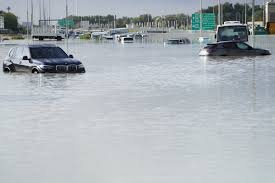The desert nation of the United Arab Emirates attempted to dry out Wednesday from the heaviest rain ever recorded there after a deluge flooded out Dubai International Airport, disrupting flights through the world’s busiest airfield for international travel.
The state-run WAM news agency called the rain Tuesday “a historic weather event” that surpassed “anything documented since the start of data collection in 1949.” That’s before the discovery of crude oil in this energy-rich nation then part of a British protectorate known as the Trucial States.
Rain also fell in Bahrain, Oman, Qatar and Saudi Arabia. However, the rains were acute across the UAE.
One reason may have been “cloud seeding,” in which small planes operated by the government fly through clouds burning special salt flares. Those flares can increase precipitation.
Several reports quoted meteorologists at the National Center for Meteorology as saying they flew six or seven cloud-seeding flights before the rains. Flight-tracking data analyzed by The Associated Press showed one aircraft affiliated with the UAE’s cloud-seeding efforts flew around the country Monday.
The National, an English-language, state-linked newspaper in Abu Dhabi, quoted an anonymous official at the center on Wednesday as saying no cloud seeding took place on Tuesday, without acknowledging any earlier flights.
The center did not respond to questions Wednesday from the AP.
The UAE, which heavily relies on energy-hungry desalination plants to provide water, conducts cloud seeding in part to increase its dwindling, limited groundwater. Scientists also say climate change in general is responsible for more intense and more frequent extreme storms, droughts, floods and wildfires around the world.
The rains began late Monday, soaking the sands and roadways of Dubai with some 20 millimeters (0.79 inches) of rain, according to meteorological data collected at Dubai International Airport. The storms intensified around 9 a.m. local Tuesday and continued throughout the day, dumping more rain and hail onto the overwhelmed city.
By the end of Tuesday, more than 142 millimeters (5.59 inches) of rainfall had soaked Dubai over 24 hours. An average year sees 94.7 millimeters (3.73 inches) of rain at Dubai International Airport, a hub for the long-haul carrier Emirates.
At the airport, standing water lapped on taxiways as aircraft landed. Arrivals were halted Tuesday night, and passengers struggled to reach terminals through the floodwater covering surrounding roads.


